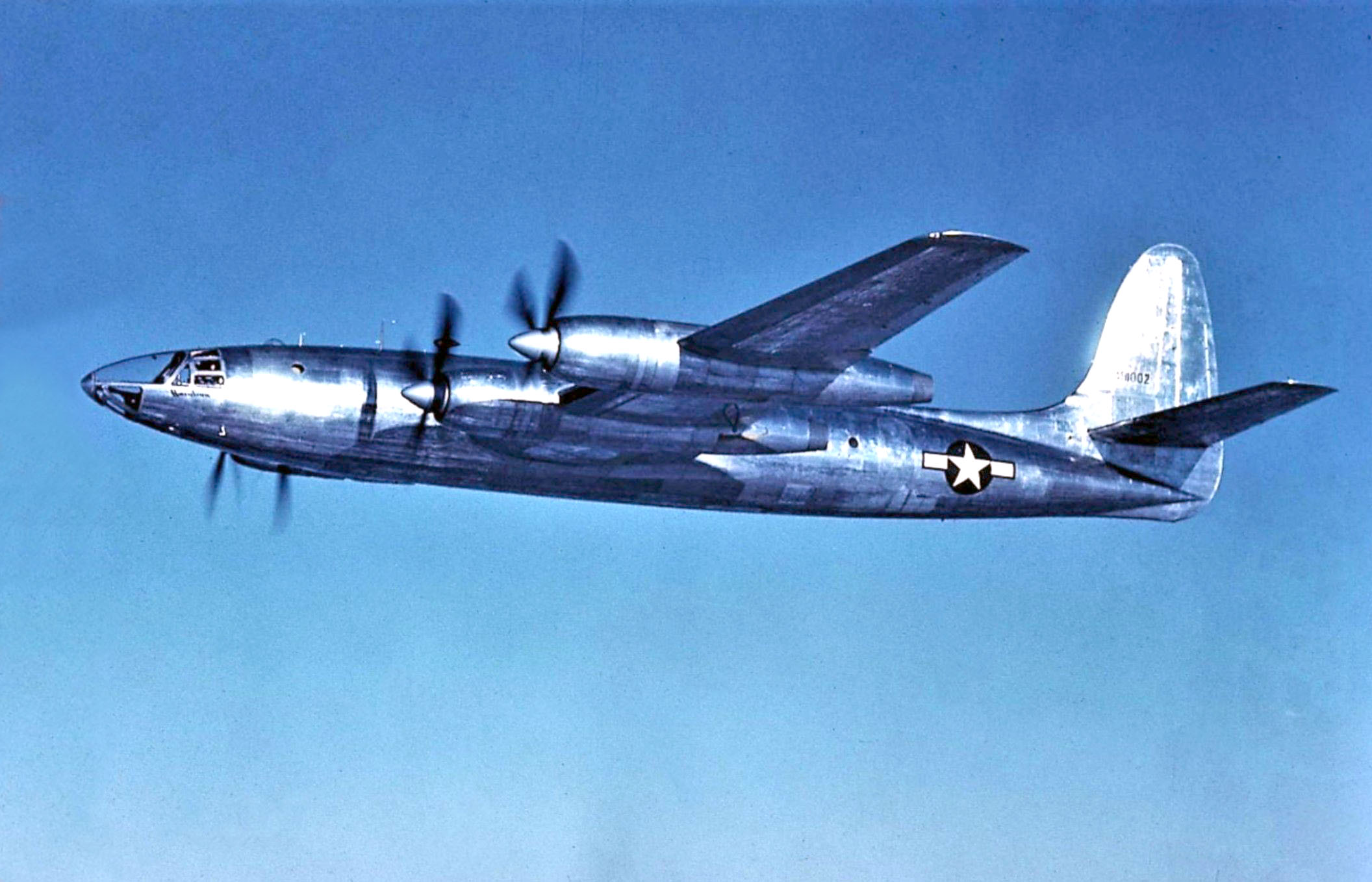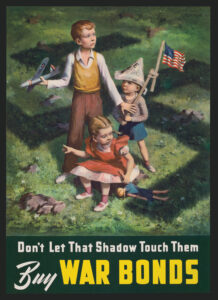In real estate, it’s location, location, location. In aircraft, it’s timing, timing, timing. Some examples proving this aphorism include the Messerschmitt Me-262, Martin-Baker MB-5, Dornier Do-335, de Havilland Comet, General Aviation GA-43 and Republic XF-12 Rainbow. Later designated the XR-12, the Rainbow is widely regarded as perhaps the most beautiful and certainly the fastest four-piston-engine airplane of all time.
Different circumstances dictated the timing failures of these aircraft. Inadequate engine development held the Me-262 back, while a dithering bureaucracy did the same for the Do-335. The Comet’s timing was fantastically good until the sad discovery of its fatal structural flaws. The far less well-known GA-43 encountered two roadblocks. First, it arrived just as the Great Depression got into full swing. Then the Civil Aviation Administration ruled adversely against single-engine passenger-carrying aircraft. The MB-5, a very handsome high-performance fighter, would have been produced in quantity had it not been preempted by the arrival of the jet age. The XF-12’s fate was affected by both the promise of the jet engine and by the imminent end of World War II.
Of all these aircraft, the Rainbow’s story is the saddest. If the talented team at Republic had been tasked with developing it just two years earlier, it almost certainly would have entered service in the U.S. Army Air Forces. Then, as with the Lockheed Constellation, it probably would have been phased over to civilian use at the end of the war. Had this occurred, Republic might have been able to create a new line of commercial aircraft to sustain it when the military’s demand for its rugged fighters at last expired.
Yet in the fall and early winter of 1943, the end of the war did not seem imminent. There had been victories at Midway and El Alamein to be sure, and the fight at Stalingrad was clearly going against Germany. Nonetheless, both Japan and Nazi Germany still loomed as powerful enemies.
Thus prospects seemed bright as the Republic engineers, led by the inimitable Alexander Kartveli, worked on a government Request for Proposal (RFP) for a new specialized photoreconnaissance aircraft. Despite the far-seeing efforts of pioneers such as Brig. Gen. George W. Goddard, the United States had totally neglected the development of dedicated photoreconnaissance planes. When war came in December 1941, a number of fighters and bombers were converted to photorecon duties, and served as well as their sometimes-limited space permitted. None had been designed for that specialty from the drawing board up, however, and none were able to accommodate the new equipment becoming available for the task.
Born in England, Goddard immigrated to the United States in 1904. He was visually oriented, and worked as a professional cartoonist after attending college classes. In December 1917, he enlisted as a private in the Aviation Section of the Signal Corps, beginning a distinguished military career that would see him gain first his wings and then his commission. During the course of his long service he became as important to aerial reconnaissance as Bernard Schriever would later become to the space program. Goddard almost singlehandedly pioneered night photography, color photography, high-altitude reconnaissance techniques, stereoscopic photography and the strip-film camera for the U.S. Army Air Service and Air Corps. Although he retired in 1953, as a consultant he made important contributions to the photo analysis done during the 1962 Cuban Missile Crisis. Many of his advances were adopted for use in space vehicles.
Thanks to Goddard, the nascent XF-12 became a platform for sensational new reconnaissance equipment and new techniques for using it. Its competitor for that role, the Hughes XF-11, had a more specialized capability.
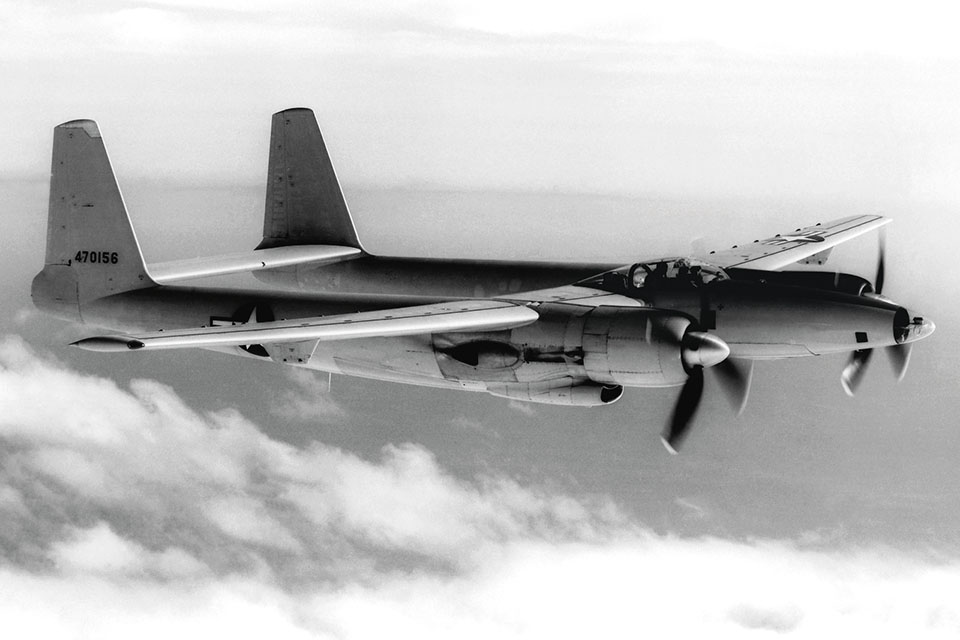
Another proponent of the dedicated reconnaissance aircraft was a relatively young officer with impeccable political connections, Colonel Elliot Roosevelt. The son of FDR, he had commanded a Lockheed F-5 Lightning squadron and was convinced that a specialized reconnaissance airplane was a military necessity. As the president’s son, he had more influence than most colonels on General Henry H. “Hap” Arnold, and was a key figure in getting the ball rolling for a dedicated reconnaissance plane. Colonel Roosevelt’s role in this process was subsequently tarnished, however, when it appeared that he had been unduly influenced by the lavish entertainment provided to him by Hughes Aircraft Corporation. Hughes was pushing a development of its ill-fated D-2, with its usual demands for departures from the well-established wartime procurement process. Despite this, the young Roosevelt’s influence placed the Hughes XF-11 in a strong competitive position.
A seldom remarked upon factor helped both airplanes gain contracts. Even by this relatively early point in the war, the American war machine was maturing, and the people guiding it realized that U.S. industry was capable of undertaking almost any production task assigned to it. To everyone in the procurement process it seemed there was both the money and the manufacturing capacity to produce almost any airplane required.
Both Republic and Hughes had their work cut out for them, for when the USAAF RFP appeared in October 1943, it imposed design requirements that would have seemed absurd just two years earlier. The new reconnaissance plane was to have a top speed of 400 mph, a range of 4,500 miles and operate at 40,000 feet.
Hughes, Boeing and Republic bid on the contract. Each company’s circumstances were very different. Boeing was the world’s leading producer of high-speed four-engine aircraft. Its latest product, the B-29 Superfortress, had flown on September 21, 1942, and was clearly capable of the required range, if not the speed and altitude demanded by the RFP. Hughes was still an outlaw brand, without experience (or manufacturing floor space) to deliver significant quantities of aircraft. Howard Hughes himself was potentially unreliable, and there was a growing undercurrent of concern about influence being exerted on his behalf. Republic’s physical plant and capabilities fell somewhere between the two. In the end, Hughes got a contract to produce a twin-engine, single-seat, fighter-like aircraft, the XF-11, and Republic was to build a four-engine plane with sophisticated onboard equipment.
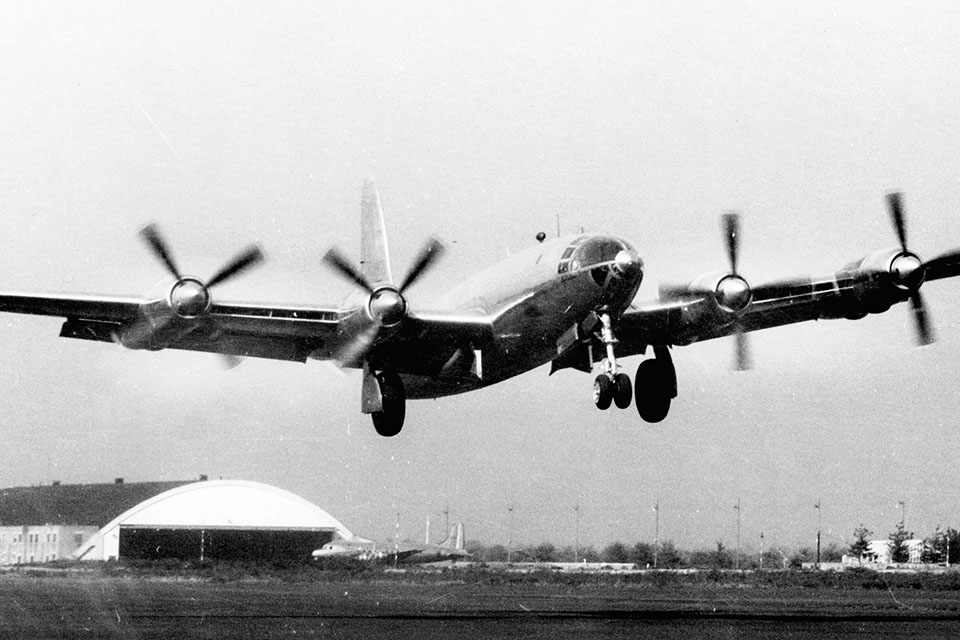
While Republic Aviation had blossomed in size and manpower from the tiny firm founded by Alexander de Seversky in 1931, it was essentially a Johnny-one-note manufacturer, concentrating on large, powerful fighters such as the P-47. The mighty Thunderbolt had been developed from the initial record-setting Seversky SEV-3 of 1933, an all-metal, three-seat amphibian monoplane capable of 230 mph, at a time when the new Boeing P-26 was causing a sensation at 234 mph. Although often attributed solely to de Seversky, the design was a joint effort by him, Michael Gregor and Kartveli. (I don’t believe full tribute has been paid to the number of Russian engineers who came to the United States after World War I. They include de Seversky, Gregor, Kartveli, Igor Sikorsky, Michael Gluhareff, Michael Buivid and others.)
Republic knew the bonanza of military contracts would dry up at war’s end. It also knew how competitive such an environment could be. Its predecessor, the Seversky company, had foundered before the war in a long, failing struggle to survive. Republic was determined to “diversify,” a term not as common then as it is today. Many other companies tried to do the same, ultimately with poor results. Republic did far better than most by developing Percival Spencer’s ambitious amphibian Air Car into what became the RC-3 Seabee. More than 1,000 were produced, and many survive today.
Winning the XF-12 contract gave Republic its last chance to diversify by producing a commercial airliner, the RC-2. The competition was tough. Douglas dominated the civil airline market before the start of World War II, and intended to continue doing so. Other players included Lockheed’s Constellation, Boeing’s Stratocruiser and Martin’s smaller 202. The first drawings of the sleek Republic XF-12 had scarcely been made when illustrations appeared of the RC-2 bedecked in the markings of various airlines.
The design was indeed very sleek, almost as if Kartveli was rebelling against the rather rotund shapes that circumstances had forced upon his fighter line, and was determined to create an aesthetically pleasing aircraft. The trademark elliptical wing shape of the fighters was gone. Instead, mid-mounted, slightly tapered but straight, high-aspect-ratio laminar-flow wings seemed to flow out from the fuselage, unencumbered by filets. Mounted on the wings were four powerful 28-cylinder Pratt & Whitney R-4360 engines, each one in a striking low-drag nacelle as long as a P-47’s fuselage. The nacelles extended as far to the rear of the wing as they did to the front, and were completely devoid of drag-inducing scoops or cooling flaps. Yet their size and shape provided ample room for twin General Electric turbo-superchargers and many other accessories. The wing design also incorporated ingenious leading-edge air inlets mounted between the inboard and outboard engines, providing sufficient ram air for the turbochargers, engine intercoolers (a necessity on the R-4360) and other systems.
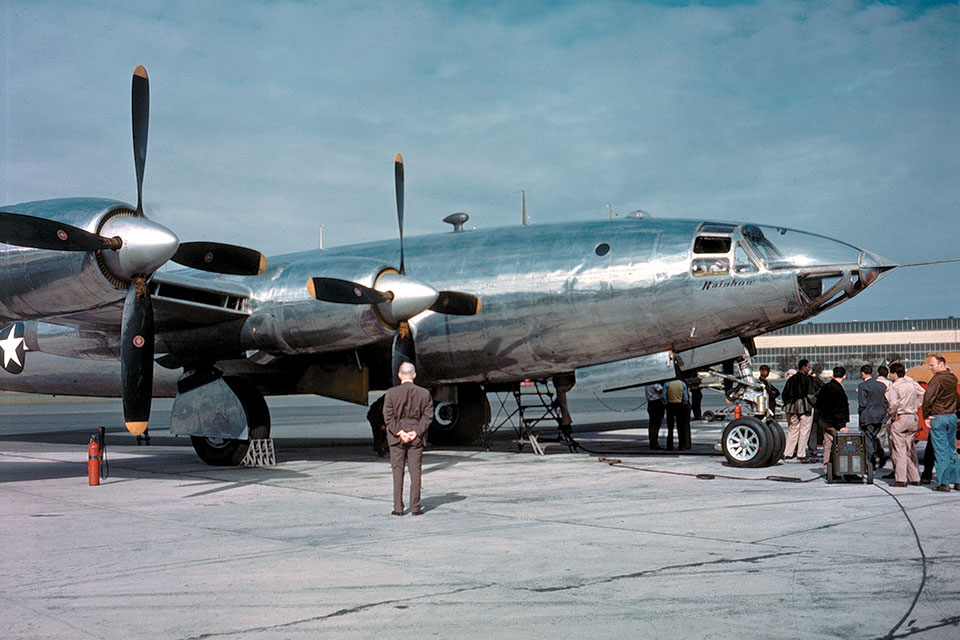
Yet as well conceived as the wings and engines were, at the heart of the Rainbow mystique was its beautiful fuselage. Kartveli and his team sacrificed some manufacturing ease by creating a long, slim fuselage that was perfectly circular in cross-section and tapered from nose to tail, a marked contrast to the constant-section fuselages found in most airliners. The goal was efficiency and low drag, reached by obtaining a very high fineness ratio (the relationship of the fuselage length to its maximum diameter) of 9-to-1.
The Rainbow’s signature note was its fuselage nose, a bullet-shaped clear section of complex construction. The pressurized cockpit section ended in a flat windscreen that was streamlined by an unpressurized Plexiglas cone, reducing drag and providing excellent visibility. While the B-29 and B-50, with their large glassed-in cockpits, provided better visibility than previous bombers, they didn’t offer the Rainbow’s unobstructed view due to the bombardier’s equipment and the number of structural elements the glazing required.
The Rainbow’s beautiful appearance extended to its empennage (although some purists take issue with the shape of the vertical stabilizer). Kartveli’s usual thoughtful attention to detail was evident throughout the aircraft.
The Rainbow was to have a relatively short but varied career. The initial example made its first flight on February 4, 1946, five months after WWII ended—and with it the sense of urgency that had driven the original requirement. Lowery L. Brabham, who had taken the P-47 up on its maiden flight some five years earlier, piloted the XF-12 during a successful 45-minute sortie. The airplane handled well and promised to fulfill the high speed and altitude requirements it was designed to meet.
The XF-12 was successfully demonstrated to the USAAF pilots at Wright Field in Dayton, Ohio, but suffered a landing accident back at the Republic plant in Farmingdale, on Long Island, on July 10, 1947. Captain William W. Elliot, from Wright Field, made a hard landing that sheared the right main landing gear strut off. Luckily the Rainbow bounced back into the air, and Elliot flew it around for four hours, burning off fuel. He then made a successful one-wheel landing that minimized damage to the aircraft, but of course pulled it from the test program.
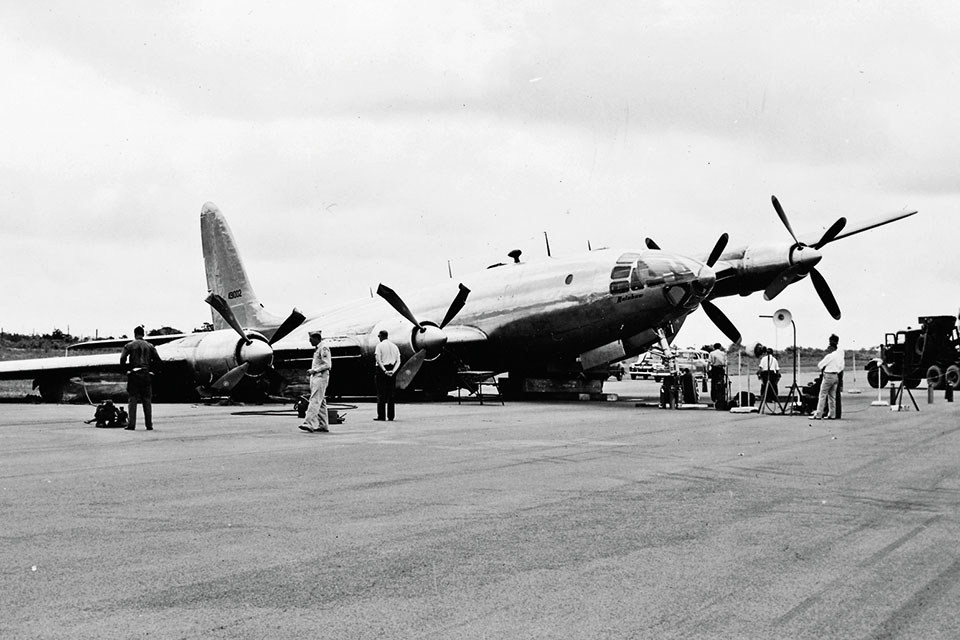
Fortunately the number-two airplane was almost ready to fly, doing so on August 12, 1947, with Oscar “Bud” Haas at the controls. Unlike the first aircraft, the second Rainbow was almost fully equipped with the sophisticated photographic gear its mission required.
On February 4, 1948, an Air Force crew flew the second Rainbow to Wright Field for operational testing. Six months later, the newly redesignated XR-12 was transferred to Muroc Field in California (soon to be renamed Edwards Air Force Base). On September 1 it took off on a mission that demonstrated its capabilities as a high-speed military reconnaissance plane. During the mission, dubbed Operation Birds-Eye, the XR-12 flew from Muroc to Ventura, Calif., there to begin a nonstop transcontinental flight in which it would map a 490-mile section of the United States. This was reconnaissance on a scale never before attempted, possible only because of the Rainbow’s advanced onboard equipment.
The XR-12 flew at a constant 40,000 feet, averaging 375 mph for the 2,700-mile, 6 hour and 35 minute flight. The photographic results were sensational, and the airplane performed perfectly. Unfortunately, it was all for naught, as the program had already been canceled. The new Boeing RB-50 could perform whatever reconnaissance might be required, and there was no military need for the aircraft in peacetime.
Despite the cancellation, test work proceeded, for data from the XR-12 could be applied to RB-50 operations. Sadly, on November 7, 1948, the XR-12 suffered an inflight fire in its no. 2 engine that caused it to crash, killing two of the seven-man crew.
That ended all prospects for the Rainbow, as Republic’s hopes for its RC-2 commercial version were long gone. Pan American had made a tentative order for six, with a provision for an additional 12, while American Airlines had signed a letter of intent for 20 aircraft. But a changing business climate and high unit costs led to the cancellation of those orders in early 1947.
The Rainbow’s unparalleled beauty had been matched by its outstanding performance, but neither element could overcome the hard fate of its timing. Yet in another twist of fate, timing salvaged Republic’s fortunes, as the advent of the Korean War meant huge contracts for its new fighters, the P/F-84s and their successors. Still, it would have been nice if fate had allowed the RC-2 Rainbow to succeed, and perhaps be replaced by a jet-powered RC-4 pot of gold.
Walter J. Boyne is the author of more than 50 books on aviation. Further reading: Mike Machat’s World’s Fastest Four-Engine Piston-Powered Aircraft: Story of the Republic XR-12 Rainbow.
Originally published in the March 2012 issue of Aviation History. To subscribe, click here.
To build your own replica of the sleek XF-12 Rainbow, click here.

